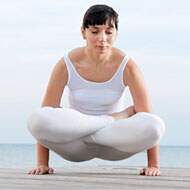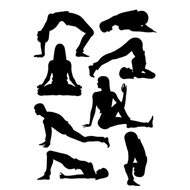- Raja yoga
- Yoga Stretches
- Jivamukti Yoga Poses
- Yoga Tree Pose
- Sun and Moon Yoga
- Wind Removing Pose
- Hare Pose
- Accomplished Pose
- Urdhva Mukha Pinch Mayurasana
- Revolved Abdomen Pose
- Raised Foot Pose
- Scorpion Pose
- Butterfly Pose
- Half Tortoise Pose
- Revolved Twist
- Balancing Stick Pose
- Cat Pose
- Supported Shoulderstand
- Crane Pose
- Handstand
- Happy Baby Pose
- Firefly Pose
- Side Plank Pose
- Upward Facing Two-Foot Staff Pose
- Reclining Big Toe Pose
- Stick Pose
- Revolved Head-to-Knee Pose
- Full Boat Pose
- Upward Extended Feet Pose
- Yoga arm balance poses
- Core Yoga
- Inversion Yoga Poses
- Seated And Twist Yoga
- Horse Pose
- Cobbler Pose
- Seated Wide Angle Pose
- The Compass Pose
- Half Crow Pose
- Bound Half Moon Pose
- Lotus Pose
- Reverse Warrior Pose
- Fixed Firm Pose
- Back-bend Poses
- Forward bend Poses
- Sarvangasana
- Ashtanga Yoga Poses
- Warm up poses
- Seated Poses
- Seated Forward Bends
- Chair Poses
- Standing Poses
- Standing Balancing poses
- Yoga Asanas
- Hatha Yoga Asanas
- Yoga Postures Online
- Partner Yoga Poses
- Anusara Yoga Poses
- Advanced Yoga poses
- Restorative Yoga Poses
- Kids Yoga Poses
- Beginning Yoga Postures
Scale Pose - Tolasana
The yoga asana or exercise, Scale Pose, is referred to as Tolasana in Sanskrit. “Tola” refers to “balance or scale,” thus indicative of the scales that your body looks like while doing this pose.
It is also known as elevated Lotus Pose. This is a great pose performed in yoga that has its focus on the development of diverse parts of your body.
Your spine, knees, and abdomen, along with your shoulder muscles are greatly benefitted by performing this yoga pose.
Tolasana (Scale Pose) aims at perking the balance of your arms. It is best done once you have mastered the Lotus Pose or Padmasana. Your legs can be best kept in a snug fit toward your body while you do this pose. You can also practice Scale Pose yoga with the help of two books placed under your arms so that you can raise your body higher.
Steps :
- Initially, seat yourself in the Lotus Pose or Padmasana.
- Your arms should rest on the floor near your hip region.
- Now, press your palms on the floor, straighten your hands, exhale, and lift your upper body.
- Stay in this posture for about 20 seconds, then lower your upper body and release your legs.
- Now, change legs in the Lotus Pose, and repeat this pose while you poise yourself on your palms again.
- Remain balanced for a while, and then return to your initial posture and relax.
Precautions :
- Certain Scale Pose precautions should also be remembered while attempting this pose.
- You should exercise caution if an injury in your shoulder or wrist is causing trouble.
- Try to avoid this posture if you have a knee or ankle related problems as well.
- The Scale Pose is also not indicated if you have tight muscles in your thighs or buttocks.
Beginner’s Tip :
As a beginner, you can still derive the benefits of Scale Pose. A beginner’s tip for the Scale Pose would be to perform it in the Ardha Padmasana or Half Lotus Pose instead of the Lotus Pose. After straightening your hands and spine, your buttocks will raise themselves off the floor, but your outer calf muscles and feel will remain on the ground.
Benefit To Body Part :
- The Scale Pose makes your arms and wrists strong.
- It involves tightening of the abdominal muscles and hence, results in a taut stomach.
- While strengthening your abdomen, it also gives an internal stimulation to the underlying organs.
- Tolasana results in strong shoulders and an increased sense of balance.
- It helps release tension from your muscles and calms your mind.
Therapeutic Applications :
- The muscles of your abdomen are pulled up tight and hence, your lungs get a better supply of oxygen as you breathe deeply.
- In Tolasana, you need to use your eyes for focused attention. This removes any common defects of your eyes.
- In totality, Tolasana improves the sense of balance of your body and has a calming effect on your whole mind and system.
Variations :
- First, take a kneeling posture and place your right ankle over the left.
- Let your body rest on the heel of your right leg.
- Placing your palms on the floor or on any block, now elevate your upper body. Unlike in Tolasana where your back is in an upright position, here your back takes a curved position and your shoulders are spread out.
- Now, exhale and release, and placing your left ankle over the right, perform the posture for about the same time period.
Preparatory Poses :
- Half Lord of the Fish Pose (Ardha Matsyendrasana), where your shoulder and neck muscles get a good stretch and the spine is strengthened.
- Bound Angle Pose (Baddha Konasana), where your thighs and knees are well stretched and the inner organs in your lower abdomen get a deep stimulation.
- Eagle Pose (Garudasana), where your thighs, shoulders, and upper back get a good stretch and your calves and ankles are strengthened.
- Head to Knee Forward Bend (Janu Sirsasana), where your shoulders and hamstrings get a good stretch.
- Lotus Pose (Padmasana), which is the base position in which the Tolasana (Scale Pose) is done effectively.
- Hero Pose (Virasana), where your thighs and ankles are stretched well and the arches of your body are strengthened.
Follow Up Poses :
- Lotus Pose (Padmasana): This is one of the best postures in yoga to maintain the erectness of your spine and the balance of your body. It is best to return to this pose and stay in it for a while after completing the Tolasana.
- Crane Pose (Bakasana): This pose stretches the back and tightens the abdominal muscles, which is similar to what the Tolasana does. It is a hence considered a good follow up pose.



